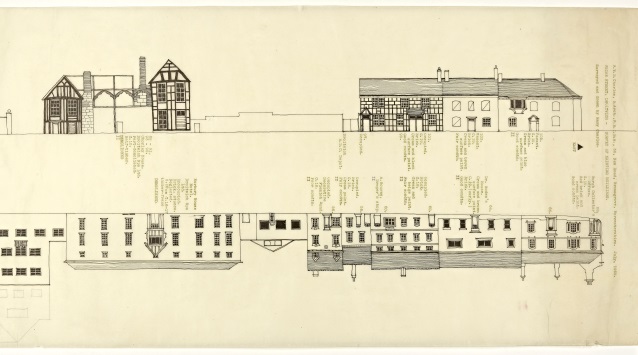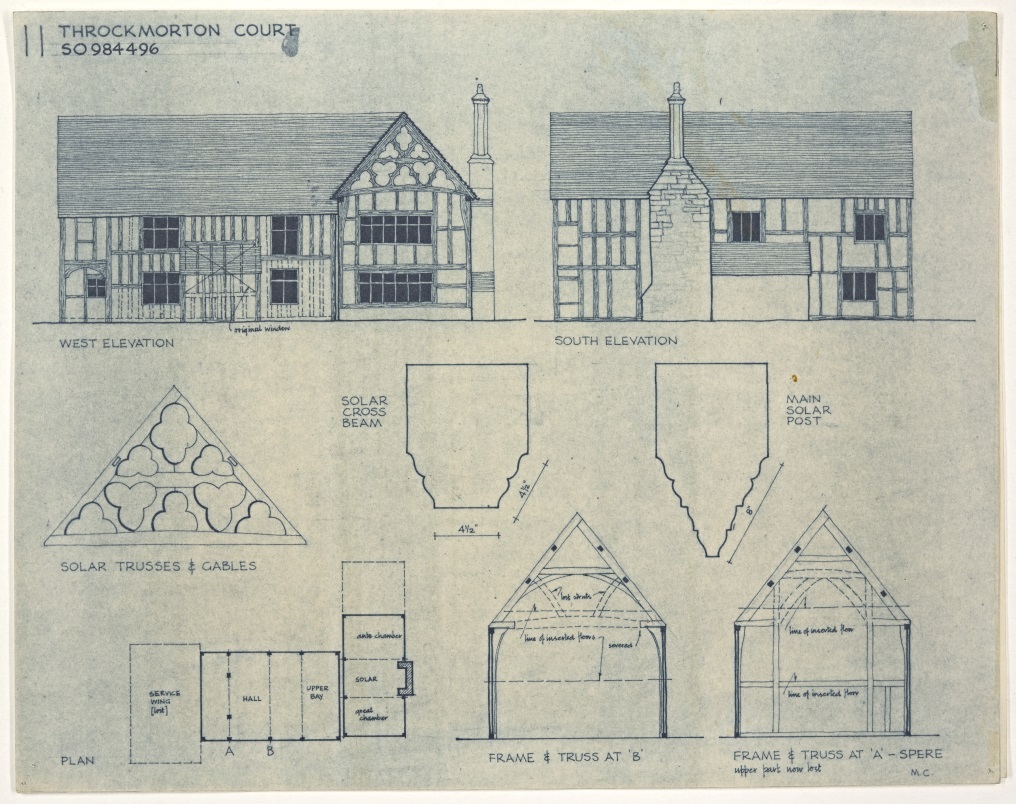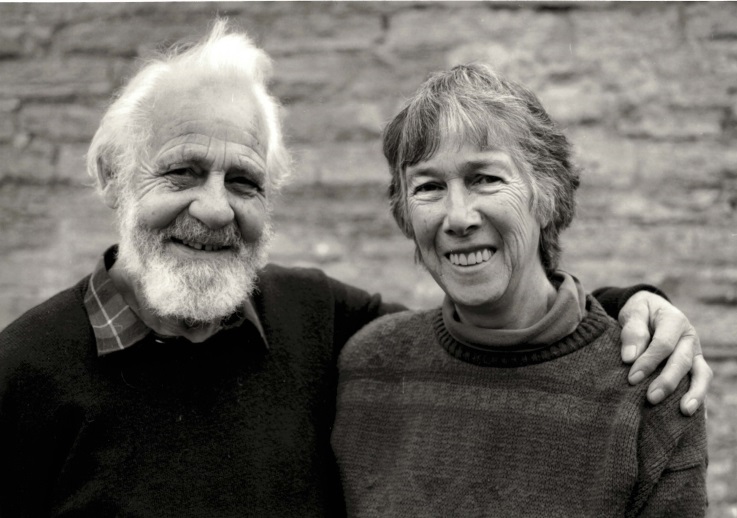The Charles Archive: Mary Charles
- 31st October 2018
This is the sixteenth in a series of blog posts celebrating the life and work of timber-frame building specialists FWB ‘Freddie’ and Mary Charles. Funded by Historic England, the ‘Charles Archive’ project aims to digitise and make more accessible the Charles Archive collection.
In this post we will be looking at the life and work of architect Mary Charles.
Mary Ellen Charles (nee Logan) was born in 1924 in Lugar, Ayrshire, Scotland. The third of four children she attended St. George’s School for Girls in Edinburgh from 1934 to 1941. St. George’s School for Girls was founded in 1888 by a group of woman, led by the prominent Scottish campaigner for woman’s education and suffrage Dame Sarah Elizabeth Siddons Mair (Stge.org.uk, 2018). The school aspired to provide girls with the same educational opportunities as boys; instead of learning to sew and follow ‘women’s pursuits’ the girls took part in gym lessons, games and scientific experiments in purpose built laboratories’ (Nickie Charles, 2018). It was the first Scottish day school which taught girls up to university entrance level (Wikipedia, 2018).
Extracts from Mary’s memoirs about her time at St. Georges School for girls
‘St. Georges School for Girls 1934 – 1941. Very important! It was built soon after the first war for girls to have the same education and equality as boys, by followers of the suffragettes. It was revolutionary to have gyms, games, labs, as normal instead of sewing (which we didn’t have) and art (which we did). Games included lacrosse, hockey, netball, rounders, tennis. The school was for day pupils and some boarders. Anita [younger sister] and I went by car from Coatbridge to Edinburgh and had every second Saturday with my parents. (Edinburgh is about 35 or 40 miles from Coatbridge).
‘When war began I was still at school. The school was evacuated to Bonchester Bridge near Hawick in Roxburghshire and housed in 3 large private houses. We had to cycle to one of the others for chemistry lessons and lacrosse was played among the cowpats. The house we (the seniors) had was owned by McEwans the brewers – that was their contribution to the war. As petrol was rationed we travelled to school by train once a term.’
Mary’s older brother Bill was an architect and appears to have greatly influenced her own career path. A ‘suffragette aunt’ potentially her father’s older sister Ellen ‘Nellie’ Montgomery Willison also seems to have been a pivotal influence in Mary’s life, perhaps encouraging Mary to pursue her career ambitions at a time when only a tiny (less than 4%) proportion of architects in the UK were women.
Extract from Mary’s memoirs about her student days
‘There was a rule that no student [to study architecture] was accepted till age 18 and as I was still 17 on passing “Highers” my parents (and Bill [older brother]) thought I should go to the Glasgow “Dough school” to learn some useful things I obviously, they thought, knew insufficient about. So I joined the church choir, sang solo in the Easter service, had to attend court and be fined for wrong parking, met a young man my father wouldn’t allow me to go out with one evening (!), learnt to drive, was a bridesmaid at Bill’s wedding.’
Mary’s architectural training was put on hold when she was called up to join the South East Scotland Regional Planning Committee in the later stages of the Second World War. It was here that Mary met her future husband the architect F. W. B ‘Freddie’ Charles. Twelve years her senior Freddie was married to his first wife, with whom he had a son, Martin.
Extract from Mary’s memoirs about being called up during WWII
‘War was still on while I was at college. I was called up while I was in second year [probably 1945]. The alternatives were, since all services were full, munitions or a reserved occupation. The college Head fixed for me to join the S.E. Scotland Regional Planning Committee just being set up. It consisted of geographers, economists, historians and architects one of whom was Dad.’ (Freddie)
By 1948 the Regional Plan had been completed and Freddie set up a private practice in Edinburgh; it’s possible that Mary assisted him. He combined this with teaching architecture in Edinburgh. The couple moved in together in 1949 and married in 1950. They went on to have three children. In 1952 the family moved to Bromsgrove when Freddie was offered a teaching position at the School of Architecture at the University of Birmingham. Mary was able to resume her architectural studies in 1959, after her youngest child started school.
Extract from Mary’s memoirs about her return to education
‘I went to the architecture school in Birmingham where dad (Freddie) was teaching 4 days a week and running a practice in the house in New Road. I had managed to complete my training up to the 3rd year by taking the intermediate (3rd year exam) externally at the RIBA in London. But I still had to do 2 years and 1 year’s practice. So I commuted to Birmingham and became a student again. ….. I found I’d forgotten everything, especially structural calculations, so that was hard.’
Mary qualified in 1961 and became an Associate of the Royal Institute of British Architects in 1963. She worked with Freddie in their private practice, initially based in Bromsgrove and then in Worcester.

Part of Digitised Illustration and Condition Survey of Friar Street, Droitwich (CA_BA14644-19_01c) © Worcestershire County Council: Charles Archive Collection. The complete illustration includes all of the buildings in Friar Street at the time of the survey (July 1960) including the late 16th century Priory House and the demolished 14th/15th century Chorley House.

Digitised original drawings of elevations and internal details of Throckmorton Court by Mary Charles, used in their publication ‘Conservation of Timber Buildings’ (CA_BA12857-13-1_01) © Worcestershire County Council: Charles Archive Collection
Qualifying at a time when few women were architects, Mary’s individual achievements and contribution to the Charles practice has – as has the contribution of so many women of her time – been overlooked and undervalued. Mary and Freddie were very much a partnership and she was essential to their joint work, managing the day to day business while Freddie focused on his research and campaigns. A talented illustrator, with a mutual passion for timber-framed buildings, Mary’s drawings bring life to many of Freddie’s publications.
‘Their work was always brought home, there wasn’t a clear separation; indeed after they closed the Worcester office in Nash House in 1991 they continued working from Churchill Mill. They often had eminent visitors at home and talked conservation, cruck barns and how to preserve buildings that were in danger of being bulldozed over meal times. Nikolaus Pevsner was one of them and Mary and Freddie helped him with the Worcestershire volume, although only Freddie was credited with this in Pevsner’s latest edition’ (Nickie Charles, 2018)
Mary Charles died on the 30th December 2005. Her quiet commitment to women’s education and equality and subtle determination to follow her own path in life deserves celebration and recognition, she really was a trailblazer in her own right.
‘Not many married women during the mid-1950’s and early 1960’s were working, let alone looking after 3 children, qualifying for an architects degree and assisting in running a business, but she seemed to think it was all perfectly normal!‘ (Nickie Charles, 2018).

Photograph of F.W.B. ‘Freddie’ and Mary Charles taken by Malcolm S. Kirk and captioned ‘with warmest memories of my stay with you at Churchill Mill’. Kindly provided by Nickie Charles
Bibliography:
Charles, F. W. B with Charles, M. (1984) Conservation of Timber Framed Buildings. London: Hutchinson
Ijeh, I. (2018). Women in architecture – on a role. [online] Building. Available at: https://www.building.co.uk/features/women-in-architecture-on-a-role/5092484.article [Accessed 22 Oct. 2018].
Charles, N. (2018). The Life of Mary Charles, including extracts from Mary Charles’ memoir.
Stge.org.uk. (2018) Our School’s History – St George’s Independent Day & Boarding School. [online] Available at: https://www.stge.org.uk/about/history/ [Accessed 22 Oct. 2018].
Wikipedia. (2018) https://en.wikipedia.org/wiki/St_George%27s_School,_Edinburgh [Accessed 22 Oct. 2018]
Lovely to see such a good photo of Freddie and Mary.
Nearly 40 years ago, when the Royal Institute of British Architects [RIBA] were selling ties and cufflinks and could not see the point of my suggestion of adding headscarves, hankies and handbags, I was asked to mentor a school kid for a week.She expressed a wish to become an architect and I arranged for her to have lunch with three female architects.
Lunch with Mary was delightful and very generous with her time. She was enthusiastic, passionate and very encouraging.
I am not sure if this little seed bore fruit but I hope that some enlightenment was provided.
PS After a long battle with Heritage England [HE], which was not uncommon, Freddie showed me his telephone doodle of the red HE fortress logo disassembled into a pile of red building blocks.
Thank you for the lovely memories.
Thank you for sharing such wonderful memories of Freddie and Mary, the story of Freddie disassembling the HE fortress logo did make us chuckle!